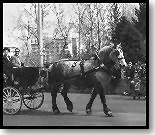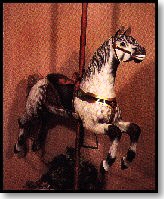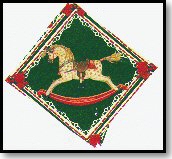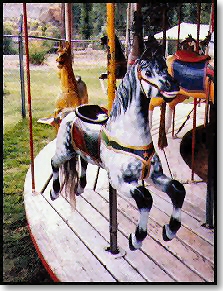 |
Painting a Historic Carousel Dapple Horse

A dapple grey
|
I thought I would
go crazy, seeing spots before my eyes, before I could figure out how to get a
carousel horse to look like the dapples in the old photographs and paintings I
had come across. In doing research I found out that a dapple grey wasn't a
recognized breed and yet it was considered the most popular horse to own
during the Victorian period. Where did they get these horses? WHO was breeding
them? Were they a genetic accident?
I looked up pictures of Lipizzans and Arabians and Pintos and Appaloosas
but none looked like the photos of the
early carousel and rocking horses. Heck, my oldest son's first horse even
qualified and she was half "Welch" and half "American Saddler". The more I
looked, the more photo references I came across of the carved replicas. They
appeared on carousels and on rocking horses from England to France, Germany to
America. They all looked similar in an abstract sort of way. Why did the
painters insist on painting these spotted horses?

It took three tries to get the spots just right
|
I was ready to
give it a shot. Why not? It is only paint, right! The first horse I tried my
dapple spots on I ended up painting three times. Back to research and the
telephone. I called everyone I knew who painted carousel animals. Everyone had
a different method, of course, none of which worked for me. Some were
convinced that the mane and tails were supposed to be black, others maintained
that they had to be white. One guy said he used q-tips. Okay. I had now
reached the point of frustration.

This wrapping paper unlocked one of life's little mysteries
|
Then one day, I
came across wrapping paper with an antique rocking horse on it that was
perfect. Now, mind you, I already had a file full of reference photos and
clippings. I had also jumped fences, dodged cows and other critters in order
to waltz up to strange horses to take close-up photos of their body parts.
Including big, huge draft horses and Morgans, no mere Budweiser Clydesdales
for me. I was driven. I was determined to figure this one out. And there it
was, the answer to my dilemma on wrapping paper. Where the horse was white, it
had black spots, and where it was black, it had white spots.
I then remembered
stories my father used to tell about horse thieves who would paint stolen
horses with spots to change their color. They would dip eggs into stove black
( a thin paint used on cook stoves and pipes) and using both ends of the egg,
paint small and large spots on the horses. It was also used to disguise the
age of the horse, the more spots, the younger the animal. So all I needed was
a round brush that I could use to create these elusive round spots.
I had this marvelous 1890's Allen Herschell horse in my studio. It was
repaired, sanded, primed - a pristine white creature who was begging for the
spots of a true "carousel" dapple grey. In my earlier attempts I had used
enamel paints and all my spots had blended together. Primer dries faster and has
more texture and if I applied a clear finish over the top, it would be
durable. All I needed to do was add the spots. Since both my primer and my
enamels were alkyd based, they could be mixed.

The finished Dapple Grey, on the carousel in Republic, Washington
|
Out came all my
reference pictures and a very worn "relaxed" stencil brush the diameter of a
quarter. Using it and a 1" inch cheap bristle brush I began to paint with the
black flat (low-luster) enamel and white primer. I shaded and dappled with the
1" brush, pushing the paint onto the horse, and I used the stencil brush to
apply the alternate colored spots. By using the inexpensive brush, I could
abuse it to create the hair texture I wanted. By working wet-in-wet and moving
quickly around the horse, my elusive dapple spots began to appear.
The primer
dries faster than normal enamel paint so I was able to create the "hairs" of
the individual spots by coming back to an area when the paint began to get
"tacky" and push or stencil the alternate colored spots into it. Nearly
straight black gave me the dark shades at the knees, around the hoof, and at
the withers. Then I stippled a blend of black and white using the "dry brush"
onto the black to give the effect of hair in the shaded areas. I kept going
around and around the horse, a spot here, a dapple there. I worked fast,
stepping back often to check out the "look" with my reference photos. The
adrenaline was rushing, it was happening. I had created a true, historic
dapple grey carousel horse.
My favorite horse to paint now is the dapple because I have conquered the
challenge. When you do this, it becomes your favorite because you know what it
took to get you there. This little Allen Herschell can be ridden on the
restored merry-go-round in Republic, Washington.
The other points I would like to stress:
- Build a "reference" file of photos and clippings to aid in your painting.
- Always work in "paint families". In this example I used alkyd enamels, oil
artist paints, and primers that are all linseed oil based . . . or of the
same paint family.
- The colors used on an antique animal should be appropriate to the colors
popular for the same period. These colors can be found in photos or
paintings of houses, interiors, and even fashions of the same period.
|
Bette Largent is a professional carousel horse restoration artist from
Washington State, and the author of
Paint The Ponies,
a guide for those who are interested in learning the art of painting
carousel figures.
Click
Here
for information on ordering her book.
|
|
 |
